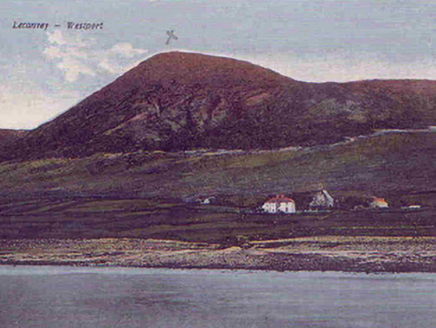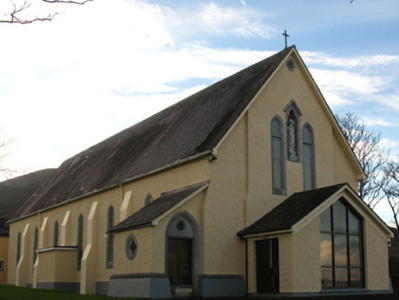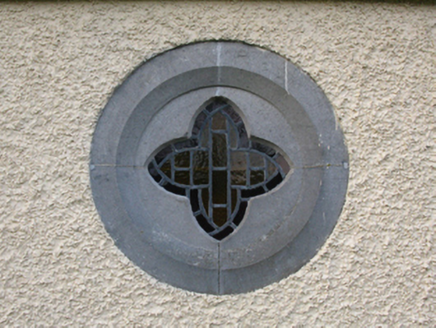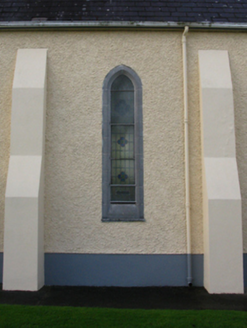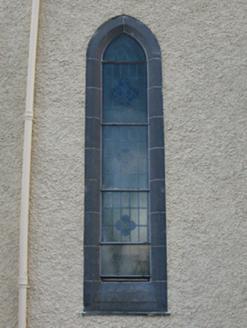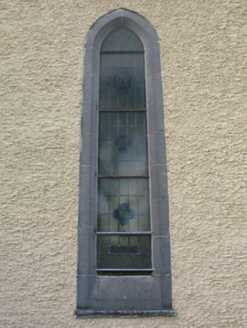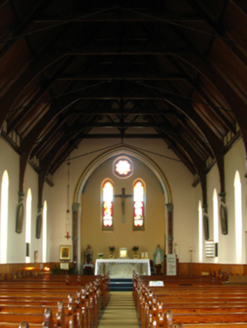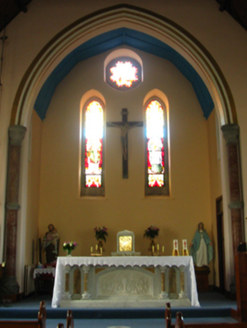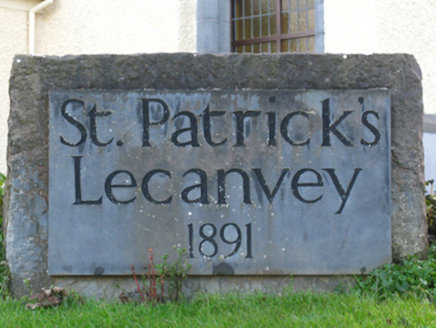Survey Data
Reg No
31308702
Rating
Regional
Categories of Special Interest
Architectural, Artistic, Historical, Social, Technical
Original Use
Church/chapel
In Use As
Church/chapel
Date
1890 - 1895
Coordinates
88883, 282448
Date Recorded
19/11/2010
Date Updated
--/--/--
Description
Detached seven-bay double-height Catholic church, dated 1891; extant 1897, comprising six-bay double-height nave opening into single-bay double-height chancel (south) with single-bay single-storey lean-to porches centred on single-bay full-height buttressed breakfront to entrance (north) front. Renovated, 1968, with sanctuary reordered. Replacement pitched slate roofs with lean-to slate roofs to porches, clay ridge tiles terminating in Cross finial to apex to entrance (north) front, and uPVC rainwater goods on eaves boards on concrete or rendered box eaves retaining cast-iron downpipes. Roughcast walls to entrance (north) front on dragged cut-limestone chamfered cushion course on rendered battered plinth; roughcast surface finish (remainder) bellcast over rendered plinth with rendered stepped buttresses having rendered coping. Lancet window openings with drag edged dragged cut-limestone surrounds having chamfered reveals framing storm glazing over fixed-pane fittings having stained glass margins centred on leaded stained glass quatrefoils. Paired lancet window openings to chancel (south) with octafoil "Rose Window" to gable, drag edged dragged cut-limestone surrounds having chamfered reveals framing storm glazing over fixed-pane fittings having leaded stained glass panels. Paired lancet window openings to entrance (north) front centred on cusped or trefoil-headed niche with drag edged dragged cut-limestone surrounds having chamfered reveals framing storm glazing over fixed-pane fittings having stained glass margins centred on square glazing bars. Square-headed door openings in pointed-arch recesses with drag edged dragged cut-limestone surrounds having chamfered reveals framing replacement fixed-pane fittings having square glazing bars. Interior including vestibule (west); square-headed door opening into nave remodelled, 1968, with replacement glazed timber double doors having sidelights below overlight; full-height interior open into roof with carpeted central aisle between trefoil-detailed timber pews, timber boarded or tongue-and-groove timber panelled wainscoting supporting timber dado rail, Gothic-style timber stations between stained glass memorial windows (undated), exposed split arch braced strutted collared timber roof construction on dragged cut-limestone corbels with wind braced timber boarded or tongue-and-groove timber panelled ceiling on carved timber cornice, and pointed-arch chancel arch framing carpeted stepped dais to sanctuary (south) reordered, 1968, with cut-veined white marble Gothic-style panelled altar below stained glass "East Window" (undated). Set in landscaped grounds on a corner site with limestone ashlar piers to perimeter having "Cavetto"-detailed pyramidal capping supporting wrought iron-detailed cast-iron double gates.
Appraisal
A church representing an integral component of the late nineteenth-century ecclesiastical heritage of County Mayo with the architectural value of the composition, one clearly interpretable as a reduction of the nearby Saint Patrick's Catholic Church (1856-61), Louisburgh (see 31308607), suggested by such attributes as the rectilinear "barn" plan form, aligned along a liturgically-correct axis; the slender profile of the openings underpinning a streamlined "medieval" Gothic theme with the chancel defined by an elegant "South Window"; and the high pitched roof shorn of its once eye-catching bellcote. Having been well maintained, the elementary form and massing survive intact together with quantities of the historic or original fabric, both to the exterior and to the interior reordered (1968) in accordance with the liturgical reforms sanctioned by the Second Ecumenical Council of the Vatican (1962-5) where a much modified altar; and some vibrant stained glass, all highlight the artistic potential of the composition: meanwhile, an exposed timber roof construction pinpoints the engineering or technical dexterity of a church making a pleasing visual statement in the shadow of Croagh Patrick.
